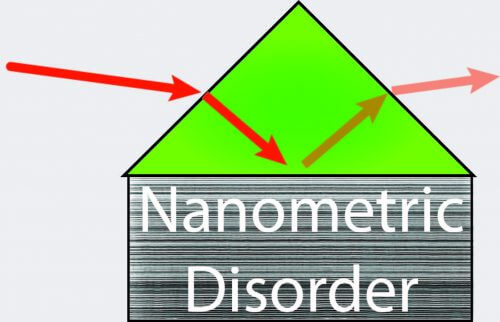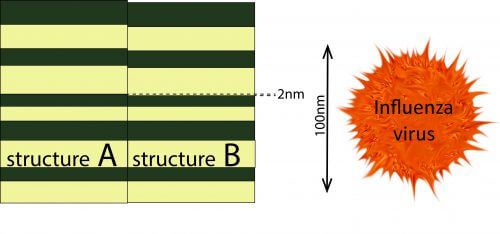Newspaper Science Reports a breakthrough by researchers at the Technion and their partner in the USA: sensing at the nanometer scale using visible light

There is a principle in optics that says that light is not sensitive to bodies whose size is relatively small along the optical wavelength. However, in an article published last Thursday in the journal Science, researchers at the Technion and their partner at the City University of New York present optical sensing of objects 100 times smaller than the wavelength.
The Technion researchers are the Ph.D. student Hanan Herzig Shinfox and Dr. Yaakov Lommer from the research group of Research Prof. Moti Segev from the Faculty of Physics at the Technion, Dr. Guy Ankonina from the Russell Berry Institute for Nanotechnology and the Grand Energy Program and Prof. Guy Bartel from the Faculty of Electrical Engineering Viterbi at the Technion, and the American researcher is Prof. Azriel Z. Ganac.
The research presented in the article deals with a "tower" of nanometer layers, each of which is approximately 20,000 times thinner than an average sheet of paper. The thickness of each of the layers is intentionally random, and this nanoscale irregularity usually doesn't matter much; However, in the current experiment, it was enough to thicken one layer by only 2 nanometers (thickness of about 6 atoms) to change the amount of light reflected from the tower at a specific angle. Furthermore, the aggregate effect of these random thickness differences in all the layers creates an important physical phenomenon called Anderson Localization. The significant discovery in the research being published now is that this location, contrary to the accepted belief so far, can be important and influential even in such tiny dimensions.
Anderson localization was discovered in 1958 and earned Philip Anderson the Nobel Prize in Physics for 1977. Its principle: under certain conditions, disorder causes particles to settle in space and remain confined within a limited region. This phenomenon was first predicted in material physics research, in the context of turning conductive materials into insulators.
Experimental demonstration of Anderson localization is known to be a particularly difficult challenge, and all the more so when the disorder manifests itself only in components much smaller than the wavelength. Indeed, the random arrangement of atoms in materials such as glass is not observable with visible light; Glass, for example, looks completely uniform even in the best optical microscope available, and this despite the irregularity that characterizes it, that is, the random arrangement of the atoms within it.

Because of this, it is customary to assume that disorder on the scale of a few nanometers will not have a significant optical effect. This is the assumption that Technion researchers are now refuting.
To illustrate the experiment conducted at the Technion, let's imagine a mosquito trying to push a person. It is clear to us that the mosquito will fail because it is too weak and the human is too heavy. However, if the person is standing on a thin rope and is affected by any small force acting on him, the effect of pushing the mosquito will be much greater (even if it is not enough to move the person).
In an experiment conducted at the Technion, the researchers created a situation where the system is in a state similar to equilibrium and therefore exhibits increased sensitivity to small changes, similar to a person walking on a tightrope. The same physical instability caused the effect of the nanoscale disorder to be stronger, thus enabling the optical sensing of Anderson positions despite their occurrence at such minuscule dimensions.
The Technion researchers present the findings as proof of feasibility that may pave the way for significant new applications of optical sensing. This approach may allow the use of optical methods to create fast measurement tools to detect nanoscale defects in computer chips and photonic devices. Its importance is especially great given the fact that optical measurements are characterized by high speed and very low cost compared to alternatives such as X-ray microscopy or electron microscopy.
Research Prof. Moti Segev was born in Romania in 1958 and immigrated to Israel at the age of three. After his release from the IDF as an infantry officer, he enrolled at the Technion, where he completed a bachelor's degree and a doctorate (on a direct track) and while serving in the reserves as a patrol company commander. At the end of his doctorate (1990) he started a post-doctorate at Caltech University and after that he got an associate professor position at Princeton University in the USA, where he rose in less than five years to the rank of full professor. In the summer of 1998 he returned to Israel and joined the physics faculty at the Technion, and in 2009 was promoted to the highest academic rank - distinguished professor - given for exceptional research excellence. He has won the highest professional awards in the field of lasers and optics from the European Physical Society (2007), the Society of Opticians of America (2009), and the American Physical Society (2013). In 2011 he was elected to the Israeli Academy of Sciences and in 2015 to the American Academy of Sciences. Moti is the recipient of the Israel Prize in Physics Research for the year XNUMX.

One response
The example of the mosquito does not seem appropriate to me. I think it would be more correct to give an example of someone trying to weigh the weight of a mosquito with jade scales or measuring a mosquito with a ruler that is divided into inches.
The problem is in the ability to separate or resolve the light, because light cannot separate points whose distance between them is smaller than the wavelength. Therefore, radiation with shorter wavelengths is used, such as an electron beam, X, etc.
It is not clear from the article how they intend to force the light to create a resolution that is smaller than its wavelength.